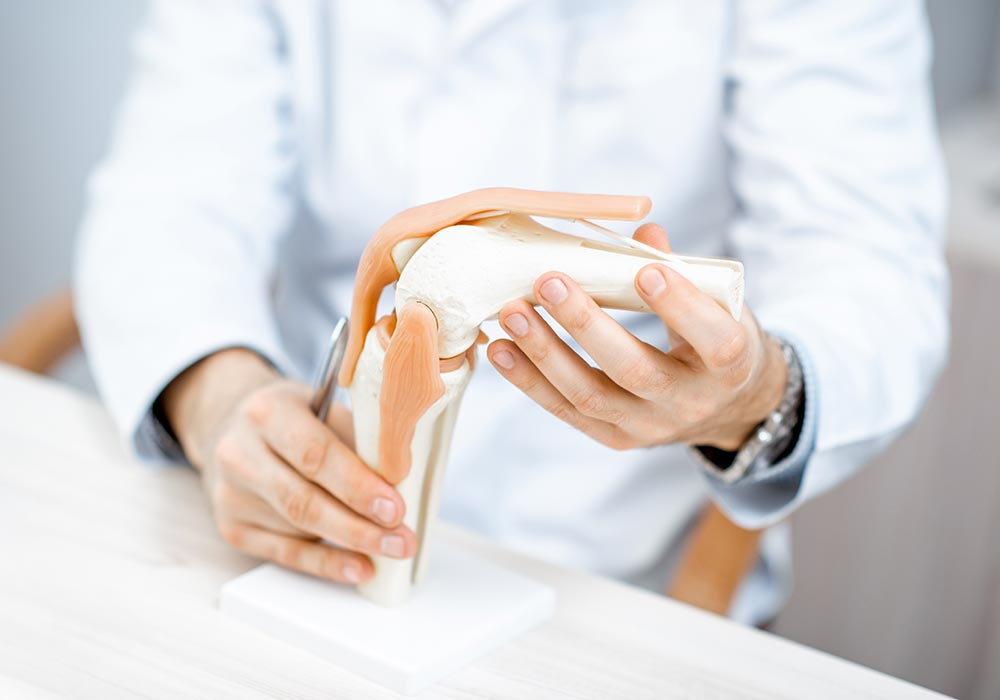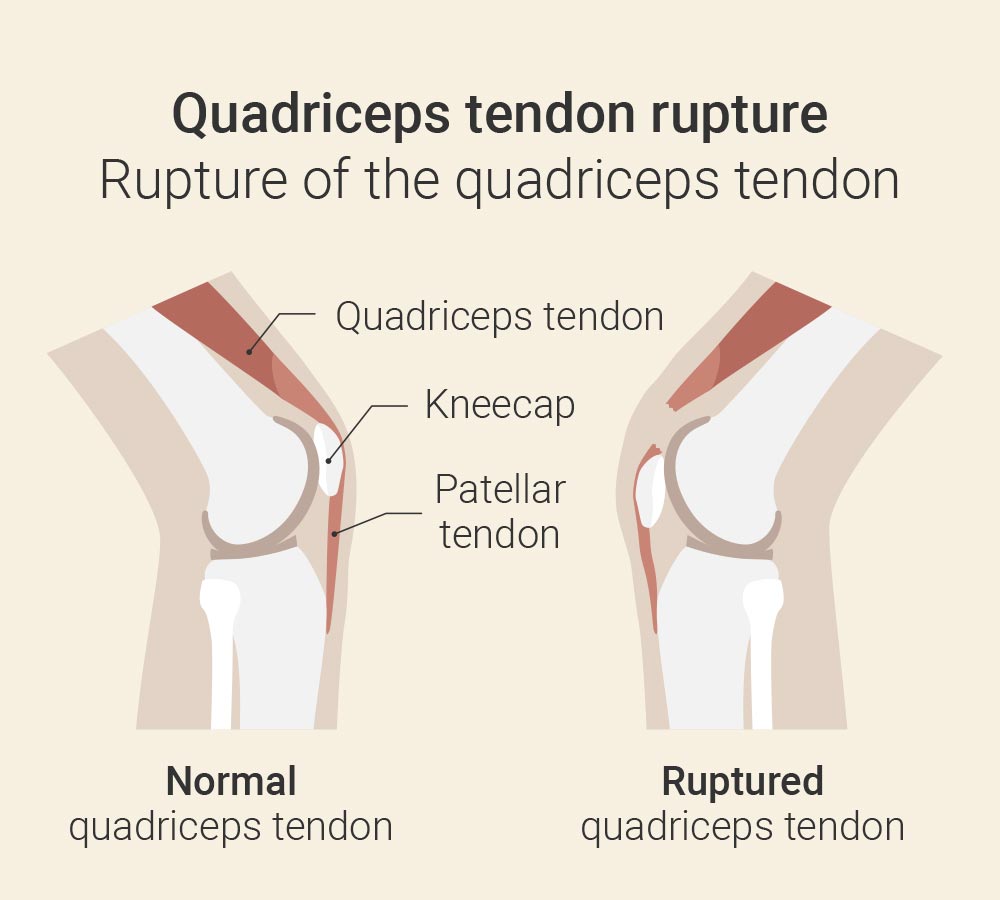A sudden, sharp pain in the front of the thigh and knee, accompanied by an immediate feeling of not being able to control the leg properly: these symptoms may indicate a quadriceps tendon rupture. Now it is important to get a quick and accurate diagnosis. Is it a partial tear or a complete tear? And which treatment is appropriate in each case? At our orthopedic practice in Frankfurt, an experienced team is at your side—with sound diagnostics, individualized advice, and a clearly structured treatment plan.

What is the quadriceps tendon?
This is a strong tendon at the front of the thigh. It connects the large thigh muscle (musculus quadriceps femoris) to the kneecap (patella).
The main function of this tendon is to transfer force from the thigh to the knee joint. This enables movements such as straightening the leg, walking, climbing stairs, or standing up from a seated position. The quadriceps tendon therefore plays a central role in the stability and function of the knee joint in everyday life and during sports.
What is a quadriceps tendon rupture?
A quadriceps tendon rupture is an injury to the tendon that connects the front thigh muscle to the kneecap. As a result, the transfer of force from the thigh to the knee joint can no longer take place properly. This makes it difficult or impossible to straighten the leg.
A quadriceps tendon rupture can occur in two forms: as a partial tear (partial rupture) or as a complete tear (complete rupture). Both variants differ significantly in severity, symptoms, and treatment requirements.
- Partial tear (partial rupture)
In a partial tear, only parts of the tendon are damaged, with some of the tendon fibers remaining intact. In many cases, active extension of the leg is still possible, albeit painful and with reduced strength. The symptoms (see below) are often less pronounced, which can lead to the injury being underestimated at first. - Complete tear (complete rupture)
A complete tear means that the tendon is completely separated from the kneecap – often with an audible tearing sound and immediate loss of strength. This means that you can no longer actively extend your leg. This type of injury is much more serious and is an orthopedic emergency.

What are the symptoms of a quadriceps tendon rupture?
Typical symptoms include:
The pain usually occurs immediately when the injury occurs. Those affected describe it as sharp and deep in the front of the knee and thigh.
Many affected individuals report a clearly audible sound at the moment of injury—often described as a pop or snap. This acoustic signal is usually accompanied by a sharp pain and unmistakably signals the moment of tendon rupture.
A key symptom is the loss of active knee extension. This means that you can no longer straighten your leg against resistance or under your own power, for example when standing up or walking.
Shortly after the injury, there is often visible swelling around the knee. Bruising (hematoma) may spread to the area above or below the kneecap.
In the case of a complete tear, a dent or indentation can be felt where the tendon was originally located (i.e., in the upper knee area).
Many sufferers feel that their knee is “no longer controllable” or unstable. Normal load-bearing capacity is severely restricted. Sufferers have no support in their knee.
Extension is severely impaired, sometimes also flexion. Everyday activities such as climbing stairs or standing up are difficult or impossible.
What causes a quadriceps tendon rupture?
Partial or complete rupture is usually caused by sudden, severe strain on the tendon – often in combination with certain risk factors or previous damage. The most common triggers include:
- Falls onto the bent knee, e.g. during sports
- Landing from a jump with an abrupt change of direction
- Uncontrolled muscle tension, for example when the body reflexively tries to straighten the leg
- Accidents in everyday life or at work, e.g. tripping or slipping
- Chronic overload, e.g. due to intensive training or physically demanding work
- Aging processes, which cause the tendon to lose elasticity and become more susceptible to damage
- Tendon calcification or micro-injuries that go unnoticed and weaken the tendon structure
- Diabetes mellitus (impairs blood circulation and can weaken the tendon structure)
- Kidney disease – especially in dialysis patients (metabolic products and mineral imbalances make the tendon more susceptible to damage)
- Rheumatic diseases (inflammatory processes can attack the connective tissue and reduce its resilience)
- Metabolic disorders such as gout or thyroid disease (promote structural changes and reduce the elasticity of the tendon)
- Cortisone therapy (long-term use interferes with tissue regeneration and weakens the tendon)
- Previous knee surgery (can weaken the tendon or alter its alignment, making it more susceptible to tearing under stress)
- Scarring or adhesions (interfere with the natural gliding of the tendon and lead to uneven stress with an increased risk of tearing)
A quadriceps tendon rupture rarely occurs “just like that.” It is often caused by a combination of stressful movement and weakened tendon structure. This makes a thorough medical examination that also takes possible risk factors into account all the more important—especially if the rupture is not sports-related.
How is a quadriceps tendon rupture diagnosed?
If you suspect a tendon rupture, our private practice for orthopedics and traumatology in Frankfurt is happy to be your first point of contact. The diagnosis is made in several steps and aims to reliably identify the injury and determine its extent.
Both clinical examinations and imaging techniques are used:
- Medical history
The diagnostic process begins with a detailed consultation with a physician. We take the time to record the exact circumstances of the accident, the type of pain, existing movement restrictions, and any pre-existing conditions. Individual risk factors such as previous knee surgery or chronic conditions are also taken into account in the assessment. This careful evaluation forms the basis for further clinical examination and any necessary imaging procedures. - Physical examination
The medical history interview is followed by a physical examination, during which we look specifically for signs of a quadriceps tendon rupture. A key feature is the active knee extension test. If you are unable to straighten your leg against resistance or under your own power, a complete tear is likely. In addition, we carefully palpate the area above the kneecap. A noticeable dent can be a clear sign of a severed or torn tendon. Swelling, bruising, and visible differences in muscle tone between both thighs are also included in the clinical assessment and help to evaluate the severity of the injury. - Imaging techniques
For further clarification, we rely on modern imaging techniques, which usually provide quick and reliable information about the extent of the injury. Ultrasound allows us to assess the continuity of the tendon. This is particularly useful in the case of fresh tears, as it allows us to determine whether the tendon is still intact or has been severed. In addition, an X-ray examination is often used to rule out bone injuries, for example, if a small fragment of the tendon has been torn off along with a piece of bone. In most cases, these two procedures are sufficient to make a clear diagnosis. However, if the findings remain unclear but the symptoms are obvious, we will arrange for magnetic resonance imaging (MRI) for further clarification. This provides a particularly detailed image and also shows possible muscle damage or accompanying injuries in the knee joint.
The combination of clinical findings and modern imaging enables a reliable diagnosis. Depending on the findings, the appropriate therapy—conservative or surgical—is then initiated.
What is the treatment for a quadriceps tendon rupture?
The treatment of a tendon rupture depends primarily on the extent of the injury, your general state of health, and your activity level. A basic distinction is made between conservative and surgical treatment:
- Conservative treatment
A conservative treatment approach is only considered in exceptional cases—for example, in cases of partial tears with preserved extension function or in older patients with severely limited health. Treatment then involves immobilizing the leg in a straight position (usually with an orthosis), accompanied by targeted physical therapy. The aim is to stimulate the tendon to heal itself while preventing muscle loss. - Surgical therapy
In the case of a complete tear, surgery is almost always necessary. The aim is to reconnect the torn tendon firmly to the kneecap. This is usually done using a suture or special anchoring techniques (e.g., bone anchors or transosseous sutures). The procedure is performed as soon as possible after the injury, as fresh tears heal better and cause fewer complications. After the operation, the leg is initially immobilized with an orthosis. You may only put limited weight on it for the next few weeks. - Rehabilitation
Rehabilitation usually begins with passive movement exercises and is gradually supplemented by active muscle training. Depending on the severity of the injury and the course of therapy, it usually takes several months before full weight-bearing and a return to sporting activities are possible.
Treating quadriceps tendon tears in Frankfurt
A quadriceps tendon rupture can occur to varying degrees – as a partial or complete tear. While a partial tear can be treated conservatively under certain conditions and healed with targeted physical therapy, a complete tear is an orthopedic emergency. In this case, the knee is unstable, active extension is difficult or impossible, and surgical treatment is usually unavoidable.
It is crucial to accurately diagnose the type of injury at an early stage through clinical examination and imaging techniques. At our orthopedic practice in Frankfurt, you will receive a thorough diagnosis, individual consultation, and professional treatment – from the initial suspicion to complete recovery.
Feel free to make an appointment!
247792665 © rh2010 | 239987380 © Aksana | stock.adobe.com